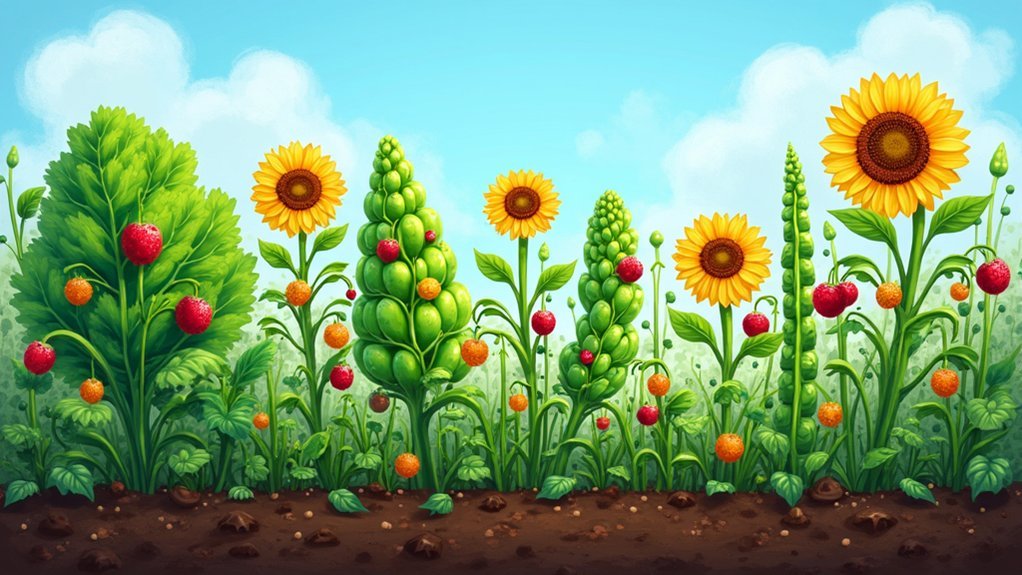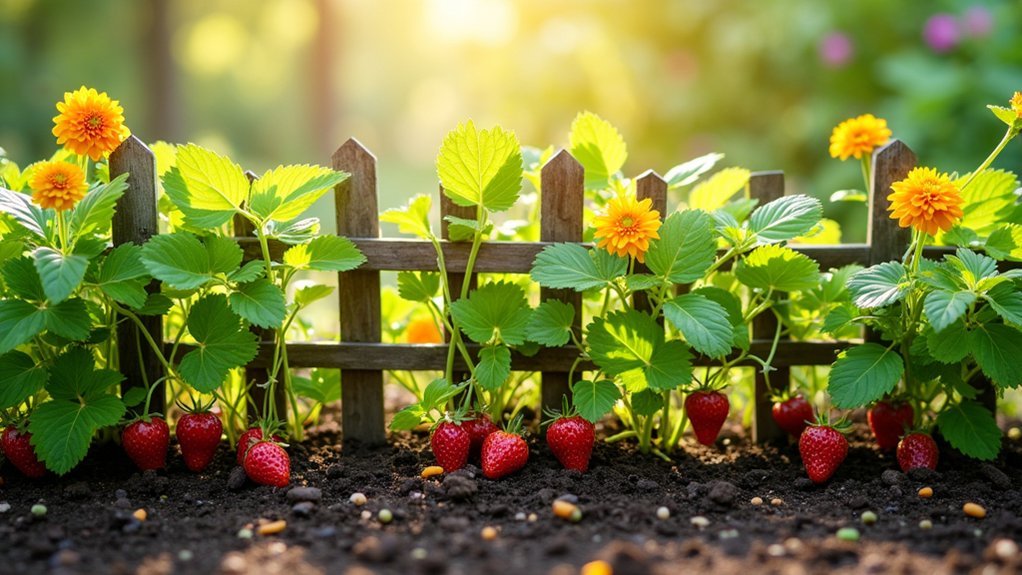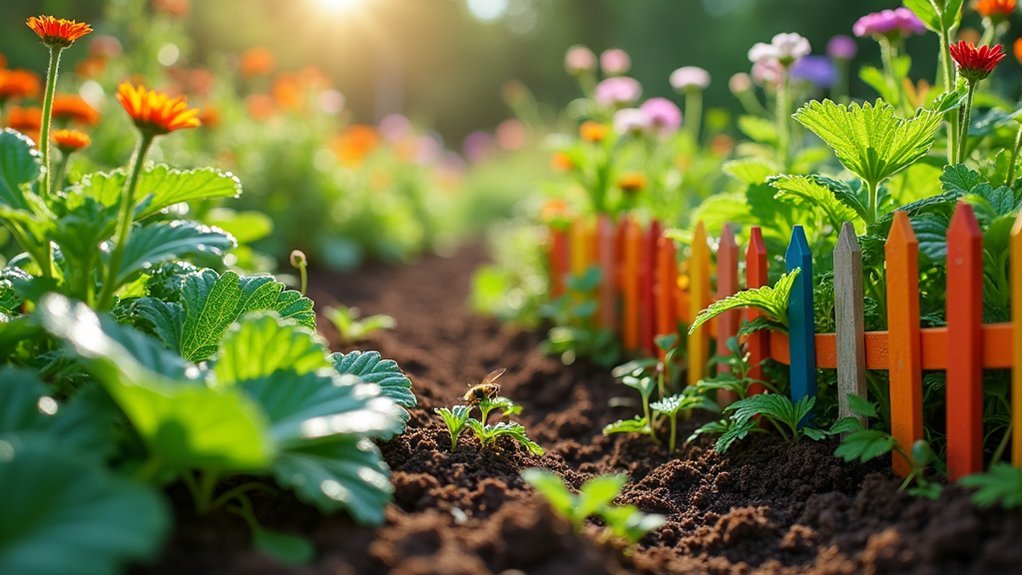Child-safe edible fences transform your school or home boundary into an interactive learning space. You’ll create a secure barrier that doubles as a living classroom where kids can safely plant, harvest, and play. Choose non-toxic climbing plants like thornless blackberries, strawberries, and green beans, and incorporate proper safety features including self-latching gates and appropriate height. With child-sized tools and seasonal activities, you’ll develop science skills, environmental awareness, and even entrepreneurial thinking through hands-on engagement with nature.
Why Edible Fences Combine Safety With Learning Opportunities

While traditional schoolyards often separate education from outdoor spaces, edible fences seamlessly blend safety considerations with rich learning opportunities.
You’ll find these living boundaries transform unused areas into vibrant outdoor classrooms where students learn about plant life cycles, nutrition, and environmental science through hands-on experiences.
When you implement proper safety protocols—including regular inspections, food safety training, and hand-washing practices—you create secure environments where children can explore freely.
These gardens naturally integrate into your curriculum, reinforcing academic concepts across subjects while teaching practical skills and follow the edible education principle of connecting school experiences to students’ real lives.
Edible fences transform curriculum into living laboratories where math, science, and literacy bloom alongside practical garden skills.
The collaborative nature of edible fence projects connects your school with community partners who provide resources and expertise.
Selecting the Right Child-Safe Plants for Your Living Fence
When designing edible fences for children, your plant selection serves as the foundation for both safety and educational value. Choose plants that combine climbing abilities, easy maintenance, and educational benefits while guaranteeing they remain safe for curious hands and mouths.
- Strawberries spread horizontally as ground cover, preventing erosion while producing sweet treats children love harvesting.
- Peas and green beans climb naturally, creating living walls while teaching children about nitrogen-fixing plants.
- Cherry tomatoes offer continuous harvests throughout summer, demonstrating fruit development cycles.
- Thornless blackberries provide climbing structure without the hazards of sharp thorns.
- Basil and rosemary add sensory elements with distinctive scents and flavors while requiring minimal maintenance.
Prioritize plants without toxic parts or thorns, and make certain all supporting structures remain stable for active children. Consider designing edible fences that receive full sun exposure for optimal vegetable and fruit growth and development.
Design Elements That Make Edible Fences Kid-Friendly

Beyond selecting the right plants, thoughtful design transforms an edible fence from a simple barrier into a child-friendly environment that balances safety with fun. The right design elements guarantee children remain secure while still enjoying and learning from your garden space. Traditional garden fences often fail to adequately deter curious toddlers who may access poisonous plants.
| Design Element | Kid-Friendly Feature |
|---|---|
| Height | Minimum 1.40m high to prevent climbing |
| Gates | Self-latching mechanisms for supervised access |
| Mesh Sections | Provides visibility while maintaining security |
| Access Points | Designated safe harvesting paths for children |
| Materials | Chemical-free composites or vinyl for safety |
Consider incorporating interactive planters at child-height and educational signage to engage young gardeners. Regular maintenance guarantees your fence remains both effective and appealing, while transparent mesh sections allow you to monitor children while they explore designated garden zones.
Creating Harvest Zones at Different Heights for All Ages
Creating harvest zones at different heights transforms an edible fence into an inclusive garden space where family members of all ages can participate.
By strategically varying fence heights and incorporating vertical growing structures, you’ll establish microclimates that extend growing seasons while making plants accessible to everyone.
- Position taller fencing on northern sides to create windbreaks that raise temperatures 5-8°F, protecting sensitive plants.
- Plant low-growing crops like kale and dwarf nasturtiums in lower zones where younger children can safely harvest.
- Train climbing edibles such as beans and cucumbers on trellises at middle heights for older children.
- Install arbors and espalier fruit trees against fences to maximize productive space vertically.
- Group plants in clusters rather than rows to create dynamic landscapes that encourage exploration.
Solid panel fencing creates effective thermal pockets in corners that can provide ideal protected spaces for heat-loving vegetables like tomatoes and peppers.
Engaging Children in Planting and Maintaining Their Fence Garden

Equip your little gardeners with appropriately sized tools like small trowels and watering cans to encourage safe interaction with their edible fence garden.
Introduce simple seasonal projects like planting peas in spring or harvesting berries in summer to maintain your child’s interest year-round. Always ensure proper handwashing before and after gardening activities to maintain hygiene and safety.
These hands-on experiences offer valuable learning opportunities as children witness the direct connection between their care efforts and the food that eventually reaches your table.
Kid-Friendly Gardening Tools
When introducing children to edible fence gardening, having the right tools makes all the difference between frustration and enjoyment. Equip your young gardeners with scaled-down versions of essential tools that fit their smaller hands and build confidence.
- Mini rakes and shovels allow children to dig and tidy garden beds without strain, building their motor skills.
- Child-sized watering cans (around $10) encourage independence and teach proper plant care techniques.
- Protective gloves shield little hands from thorns and dirt while demonstrating safety practices.
- Carry-all bags help kids organize their tools, fostering responsibility and ownership.
- Rounded-edge tools made with non-toxic materials guarantee safety while they explore and learn.
These age-appropriate tools transform gardening from an adult activity into an engaging educational adventure. Our affordable kids gardening tools are specifically designed for small hands while helping to inspire a love of nature in young gardeners.
Simple Seasonal Projects
Involving children in the garden requires more than just right-sized tools — it means planning activities that match each season’s unique opportunities. Design age-appropriate projects that maintain interest throughout the growing cycle. Young children can begin with egg carton starters while older kids may enjoy building and maintaining a container garden with more complex plants.
| Season | Quick Project | Learning Outcome |
|---|---|---|
| Spring | Start seedlings in egg cartons | Understanding germination |
| Spring | Build simple trellises | Creating vertical growing spaces |
| Summer | Assign harvest patrols | Developing responsibility |
| Summer | Plant microgreens in shade | Learning about quick crop cycles |
| Fall | Collect and store seeds | Planning for future gardens |
| Fall | Add compost to beds | Understanding soil health |
| Winter | Design next year’s layout | Practicing garden planning |
| Winter | Grow windowsill herbs | Maintaining year-round habits |
Rotate crops annually to maintain interest and incorporate taste tests comparing raw versus cooked harvests to connect growing with eating. These hands-on activities transform garden maintenance into engaging learning experiences.
Hands-On Learning Opportunities
Transforming edible fences into hands-on classrooms creates natural opportunities for children to develop lifelong gardening skills. When you involve kids in maintaining your edible fence, you’re cultivating both plants and young minds.
- Establish daily watering checks where children learn responsibility while discovering how different plants require varying amounts of moisture.
- Create simple weed identification games that teach plant recognition while maintaining garden health.
- Incorporate measurement activities tracking vine growth up trellises to reinforce math concepts.
- Set up labeled planting stations with weather-resistant markers to blend literacy with gardening.
- Organize harvest festivals where children develop leadership by planning simple ceremonies to celebrate their edible fence’s bounty.
These interactive approaches transform routine garden maintenance into engaging educational experiences that connect children with food sources and natural cycles. Encouraging children to sell surplus produce from fence gardens at mock or real markets helps them develop valuable entrepreneurial skills while understanding the farm to table connection.
Seasonal Strategies for Year-Round Edible Fence Benefits

Creating a truly productive edible fence requires thoughtful planning across seasons to guarantee your family enjoys continuous harvests throughout the year.
Start by selecting plants with staggered fruiting periods—early cherries, mid-season blueberries, and late-autumn raspberries—to extend your harvesting window.
Strategic plant timing transforms a simple fence into nature’s calendar, offering consecutive harvests from spring through fall.
Maximize vertical space with trellises supporting climbing edibles like grapes or kiwi, while using strawberries as ground cover below.
Plant in early spring after the last frost, ensuring proper spacing to prevent disease and competition for nutrients.
You’ll need to integrate both deciduous and evergreen species for year-round appeal and food production.
Consider your climate zone when selecting plants—drought-tolerant pomegranates for drier regions, or cold-hardy varieties for northern gardens.
Remember to include pollinator-friendly options that naturally enhance productivity while teaching children about ecosystem interdependence.
With nearly 30 different berry varieties in your fence garden, you’ll create incredible biodiversity while ensuring continuous harvests from June through October.
Frequently Asked Questions
How Do Edible Fences Withstand Children’s Physical Play Activities?
Edible fences don’t withstand children’s play well without support. You’ll need sturdy trellises, regular pruning, and resilient plant varieties. They’ll require more maintenance than traditional fencing to remain functional after physical interactions.
Can Edible Fences Deter Neighborhood Pets From Entering the Yard?
Edible fences can deter neighborhood pets, especially when you plant strong-smelling herbs like rosemary and lavender. They’ll create both physical barriers and sensory deterrents, but you’ll need regular maintenance for continued effectiveness.
How Quickly Will an Edible Fence Establish an Effective Barrier?
You’ll see a partial barrier within 1-2 growing seasons with fast-growing shrubs like blackberry. For complete effectiveness, expect 3-5 years, but combining fast growers with slow-maturing species creates a staggered barrier development timeline.
Are There Insurance Benefits to Installing Child-Safe Edible Fences?
You’ll find few direct insurance benefits for edible fences, though some policies may offer discounts for child safety measures. Check with your provider about potential reduced liability premiums for secured property boundaries.
What’s the Average Cost Comparison Between Edible and Traditional Fencing?
You’ll generally spend $500-$3,000 for edible fencing compared to $1,000-$7,000 for traditional options. While upfront costs are lower for edible boundaries, consider that maintenance needs and growth timelines differ considerably.
In Summary
You’ve now got the blueprint for a fence that’s so much more than a boundary. As you create your edible landscape, you’ll watch your children develop gardening skills while safely exploring nature’s bounty. Don’t wait—start planning which child-friendly plants will define your space. Soon you’ll enjoy the satisfaction of harvesting food from what was once just a dividing line between properties.





Leave a Reply